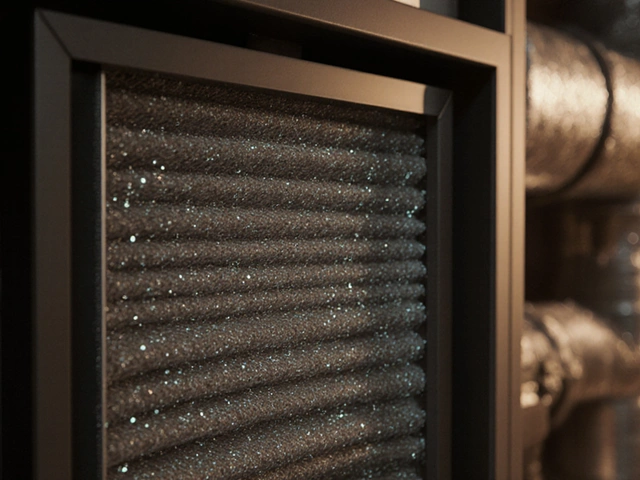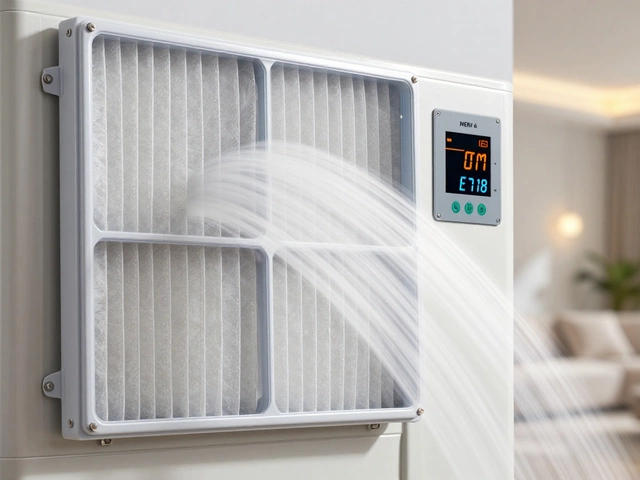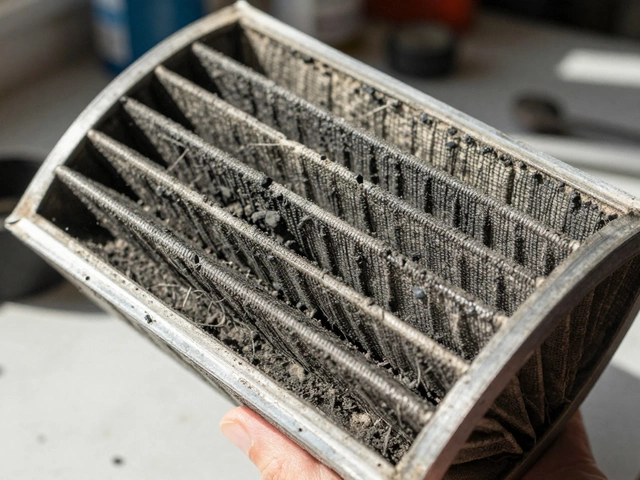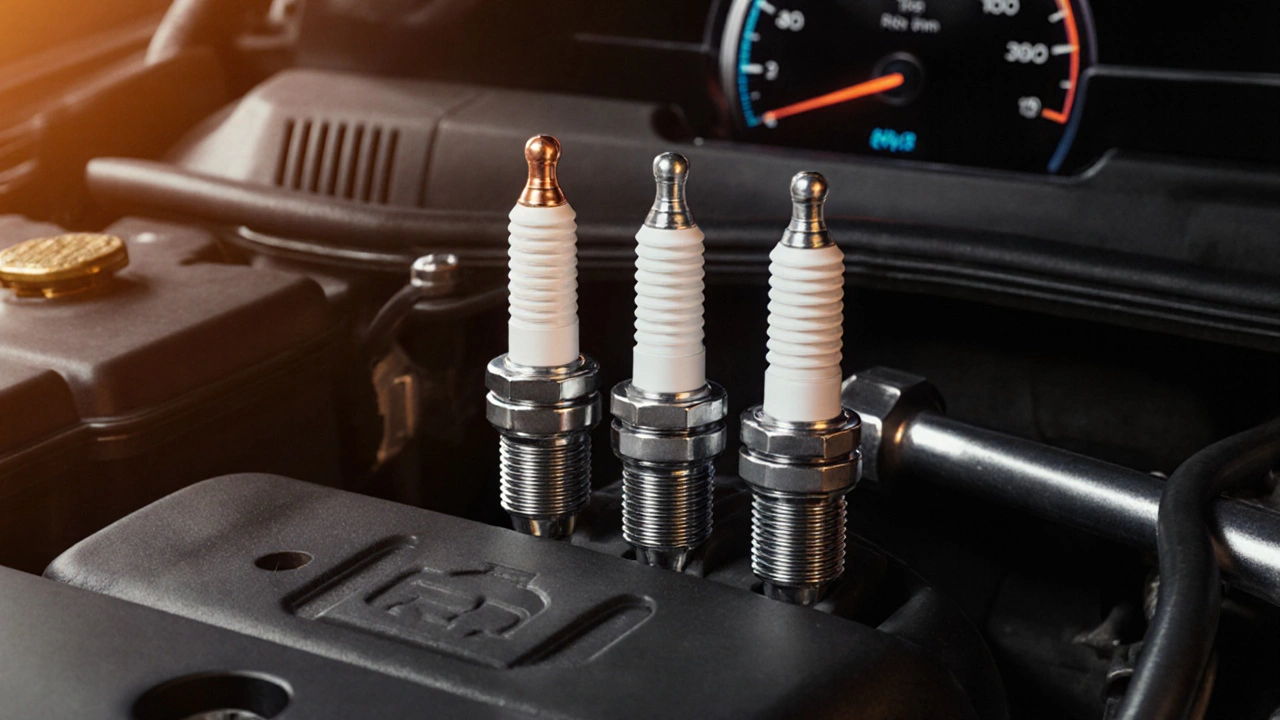
Spark Plug Lifespan Calculator
Estimated Spark Plug Lifespan
Lifespan Visualization
Spark Plug Types Overview
Copper
20,000–30,000 km (12,000–18,000 miles)
2–3 years
Cost: £4–£7 per plug
Platinum
40,000–60,000 km (25,000–35,000 miles)
4–5 years
Cost: £8–£12 per plug
Iridium
80,000–100,000 km (50,000–62,000 miles)
6–8 years
Cost: £12–£20 per plug
Ever wondered why your mechanic keeps mentioning spark plug changes? The simple answer is that spark plugs wear out, and knowing exactly how long they last can save you money, prevent engine trouble, and keep fuel bills low. Below we break down the factors that dictate a spark plug’s life, the realistic mileage and year expectations for different plug types, and a step‑by‑step plan to keep your ignition system humming.
Key Takeaways
- Standard copper plugs usually last 20000-30000km (12‑18k miles) or about 2‑3years.
- Platinum plugs extend life to 40000-60000km (25‑35k miles) - roughly 4‑5years.
- Iridium plugs can reach 80000-100000km (50‑62k miles) and often survive 6‑8years.
- Driving style, climate, and engine load are the biggest wear accelerators.
- Follow manufacturer’s recommended interval, but inspect plugs early if you notice misfires, rough idle, or reduced fuel efficiency.
spark plug lifespan isn’t a one‑size‑fits‑all number; it’s a range shaped by technology, usage patterns, and maintenance habits.
What a Spark Plug Does (and Why It Ages)
Spark Plug is a small electromechanical device that delivers an electric spark to ignite the air‑fuel mixture inside a combustion chamber. It sits at the heart of the Ignition System, converting the high‑voltage pulse from the coil into the flame that powers your engine.
Each time the engine fires, the plug’s central electrode endures a rapid temperature spike of up to 1500°C. Over time the electrode erodes, the porcelain insulator can crack, and the internal gap widens. Those changes are what we call “spark plug wear.”
Three core reasons drive that wear:
- Thermal stress from repeated heating and cooling cycles.
- Electrical arcing that gradually consumes the electrode material.
- Contamination from fuel additives, oil blow‑by, or carbon deposits.
The faster any of these forces act, the sooner the plug reaches the end of its useful life.
Typical Lifespan by Plug Type
The market offers three primary families of spark plugs, each built from a different core metal and designed for a specific lifespan.
| Material | Typical Lifespan (km / miles) | Typical Lifespan (years) | Cost (per plug) | Heat Range |
|---|---|---|---|---|
| Copper | 20000-30000km (12‑18k miles) | 2‑3years | £4-£7 | Medium‑high |
| Platinum | 40000-60000km (25‑35k miles) | 4‑5years | £8-£12 | Medium |
| Iridium | 80000-100000km (50‑62k miles) | 6‑8years | £12-£20 | Low‑medium |
Notice how the more exotic metals-platinum and especially iridium-allow the electrode to resist erosion, stretching the service interval dramatically.
But price isn’t the only factor. An engine that runs hot, or a driver who frequently hard‑accelerates, may still need to replace iridium plugs after 40000km.
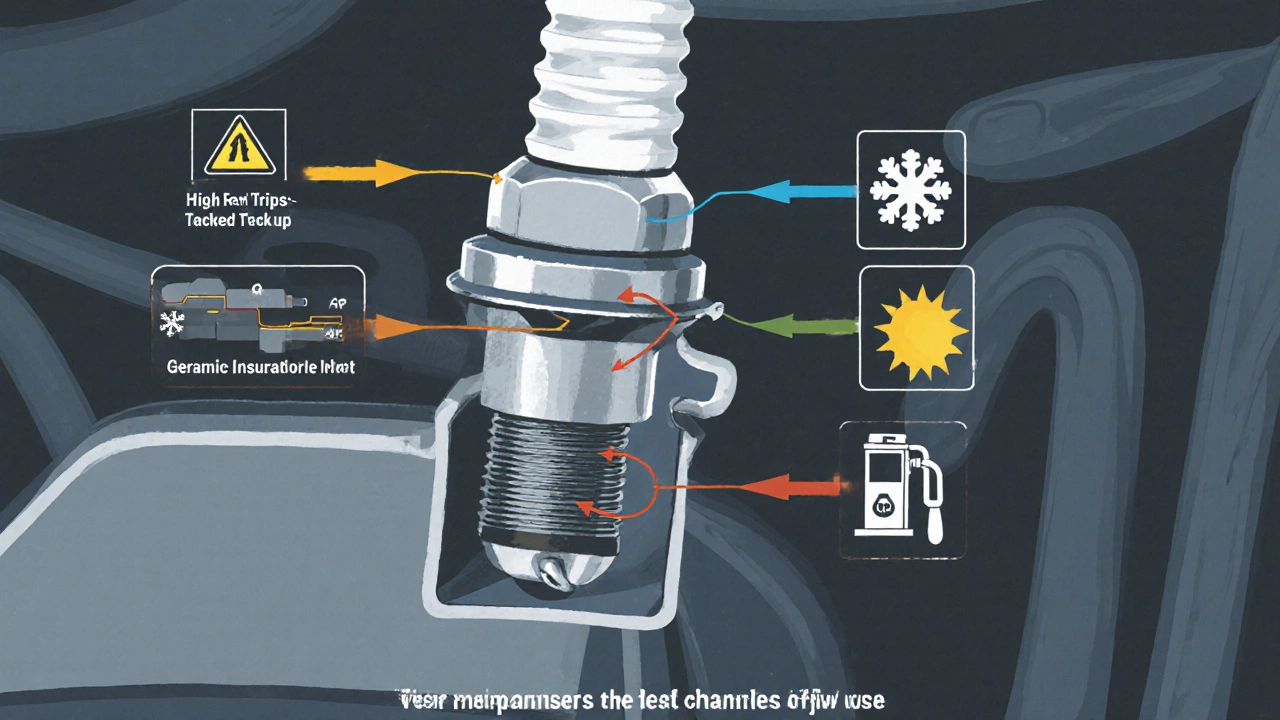
Driving and Environmental Factors That Slash Plug Life
Even the best iridium plug can wear out early if you subject it to harsh conditions. Here are the biggest culprits:
- Short trips. Repeatedly warming the engine without reaching full operating temperature leads to carbon buildup on the plug tip.
- High‑performance driving. Frequent high‑rpm revs create hotter combustion, accelerating electrode erosion.
- Extreme climates. Cold winters force richer mixtures, while scorching summers push the heat range to its limit.
- Fuel quality. Low‑octane or high‑sulphur fuels produce more fouling deposits.
- Engine oil leaks. Oil entering the combustion chamber contaminates the plug’s insulator.
Each factor forms a semantic triple: "Cold weather sulphur‑rich fuel increases carbon buildup on spark plugs."
Understanding these variables lets you anticipate when a plug will need attention, even if you’re still within the manufacturer’s mileage guideline.
How to Tell If Your Spark Plugs Are Nearing the End
Symptoms of deteriorating plugs show up as engine‑performance issues before any warning light appears. Keep an eye out for:
- Rough idle or stalling at low speeds.
- Misfire codes (P0300‑P0304) on a diagnostic scanner.
- Reduced fuel efficiency -usually 2‑5% drop.
- Hard starts, especially in cold weather.
- Engine “pinging” or knocking under load.
When any of these pop up, pull the spark plug(s) and inspect the tip. A healthy plug has a clean, rounded electrode with a gap matching the service manual. Black soot indicates a rich mixture; oily films point to oil blow‑by.
Step‑by‑Step Guide to Inspecting and Replacing Spark Plugs
- Gather tools: socket set (usually 5/8" or 13mm), spark plug gap gauge, anti‑seize compound, and a torque wrench.
- Locate the plug wires or coil‑on‑plug assemblies. Disconnect the electrical connector.
- Use the appropriate socket to loosen each plug counter‑clockwise. Pull gently to avoid breaking the ceramic insulator.
- Inspect the tip. Measure the electrode gap with the gauge. If it’s out of spec, set it to the manufacturer’s specification (often 0.6‑1.0mm).
- Apply a thin coat of anti‑seize to the plug’s threads. Thread each new plug in by hand, then tighten to the specified torque (usually 18‑22Nm for most cars).
- Reconnect the ignition wire or coil, and repeat for each cylinder.
- Start the engine and listen. A smooth idle means you’ve done it right.
If you’re unsure about torque values, consult the vehicle’s service manual-Engine manufacturers often publish exact numbers for each model.
Manufacturer Recommendations vs. Real‑World Practice
Most car makers list a mileage interval in the owner’s manual. For example, a 2022 Ford Focus with copper plugs recommends replacement at 20000km. However, real‑world tests by automotive magazines show that drivers who stick to regular oil changes and avoid aggressive driving can stretch that to 30000km without a noticeable loss in performance.
Conversely, a performance‑tuned Subaru WRX on a track schedule may need plug swaps every 10000km despite using iridium plugs-high heat and fouling outweigh the material benefits.
Bottom line: treat the manufacturer’s figure as a ceiling, not a guarantee. Adjust the interval based on the factors we discussed.
Cost‑Benefit Analysis: When Is It Worth Upgrading?
Switching from copper to platinum or iridium isn’t just about lifespan; it also improves combustion efficiency. A study by the UK Automotive Research Institute (2024) recorded a 1.3% fuel‑economy gain after fitting iridium plugs on a fleet of diesel‑powered vans. Over a 10000‑mile year, that translates to roughly £30 saved on fuel for the average driver.
Calculate your own break‑even point:
- Extra cost per plug (iridium vs. copper): £10.
- Average fuel saving per year: £30.
- Additional lifespan gained: ~3years.
With those numbers, the upgrade pays for itself in under two years if you drive more than 15000miles annually. For low‑mileage commuters, copper remains a sensible choice.
Quick Checklist Before Your Next Service
- Know your vehicle’s recommended plug type and interval (check the owner’s manual).
- Record the last replacement mileage and date.
- Monitor fuel economy; a sudden dip may signal plug wear.
- Inspect for misfire codes during any OBD‑II scan.
- Plan a plug check before major trips, especially if you’ve been riding in extreme weather.
Frequently Asked Questions
How often should I replace spark plugs on a new car?
For most new cars that come with iridium plugs, manufacturers suggest 80000-100000km (50‑62k miles) or about 6‑8years. If you drive aggressively or live in a very hot climate, check them at 40000km.
Can I mix different types of spark plugs in the same engine?
It’s not recommended. Mixing copper, platinum, and iridium plugs can cause uneven heat distribution, leading to one cylinder running hotter than the others and potentially causing premature wear.
Do I need to gap my iridium plugs?
Most modern iridium plugs come pre‑gapped to the correct specification, but it’s still good practice to verify the gap with a gauge before installation.
What are the signs of a fouled spark plug?
A fouled plug appears black and sooty, may have oil stains, or can look white and melted if it’s running too hot. These visual cues often accompany a rough idle or misfire codes.
Is it worth upgrading to iridium plugs on an older gasoline car?
Yes, if the engine is still in good condition. Iridium plugs can improve combustion efficiency and lower emissions, giving you a modest boost in fuel economy and smoother performance.
